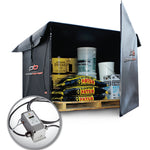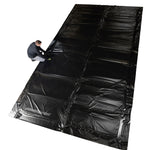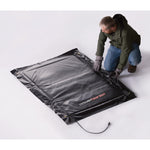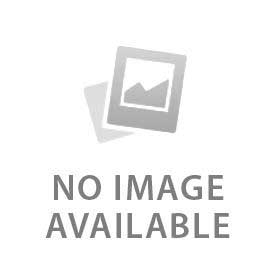You have no items in your shopping cart.
Article At-a-Glance
What is the Freezing Point of Caustic Soda Solutions?
The freezing point of caustic soda solutions varies by concentration, with a 25% solution freezing at 0°F and a 50% solution freezing at 58°F, making temperature control crucial for maintaining efficacy in wastewater treatment processes.
Key Takeaways
- Understand Freezing Points by Concentration: Caustic soda solutions have varying freezing points based on concentration, with a 25% solution freezing at 0°F and a 50% solution at 58°F.
- Impact of Temperature on Efficacy: Freezing can lead to crystallization and reduced efficacy in wastewater treatment, making temperature control essential.
- Challenges in Cold Weather: Low temperatures pose risks during storage and transportation, potentially disrupting treatment processes.
- Solutions for Temperature Control: Utilize tote and barrel heating jackets to maintain optimal temperatures and prevent freezing.
- Benefits of Heating Solutions: These solutions offer consistent heat, energy efficiency, and safety features, ensuring effective wastewater treatment.
Optimizing Wastewater Treatment: Tailored Heating Solutions for Caustic Soda Temperature Control
Caustic soda is a key chemical in wastewater treatment. Just like most other liquid materials, it is sensitive to low temperatures. Heat Authority can show you how to mitigate issues relating to the cold and increase treatment efficiency.
In wastewater and water treatment operations, where precision is paramount, caustic soda is one of the most important chemicals used to carry out treatment processes. This versatile chemical, also known as sodium hydroxide (NaOH), plays a crucial role in neutralizing acidic wastewater and facilitating various treatments. However, ensuring its optimal performance hinges on one key factor: temperature control.
In this article, we explain into the basics of caustic soda, explore the impact of temperature fluctuations, and introduce a tailored solution—tote and barrel heating jackets—for maintaining the ideal conditions in wastewater treatment facilities.
The Basics of Caustic Soda
Caustic soda, a stalwart in the realm of chemicals, is an inorganic compound with the chemical formula NaOH. Possessing unique properties, including its caustic and corrosive nature, caustic soda finds widespread application in wastewater treatment. Its primary role is to neutralize acidity, adjust pH levels, and facilitate the removal of heavy metals, making it an indispensable asset in the treatment of industrial effluents.

Caustic soda, or sodium hydroxide NaOH.
Caustic Soda and Freezing Points
One often-overlooked aspect of caustic soda is its susceptibility to temperature changes, especially freezing. Caustic soda is typically encountered in solution form, and its freezing point is a critical parameter to consider.
What is the freezing point of caustic soda?
The freezing point of caustic soda solutions varies depending on the concentration, with higher concentrations having lower freezing points. If the temperature drops below this critical point, the consequences for treatment processes can be severe, potentially leading to crystallization, reduced efficacy, and even equipment damage.
| % | °F | °C |
|---|---|---|
| 1% | 30 | -1 |
| 5% | 25 | -4 |
| 10% | 18 | -8 |
| 15% | 0 | -18 |
| 20% | -12 | -24 |
| 25% | 0 | -18 |
| 30% | 36 | 2 |
| 40% | 60 | 16 |
| 50% | 58 | 14 |
| 60% | 120 | 49 |
| 70% | 147 | 64 |
If this is a lot to remember, just know that at 25% concentration, the caustic soda freezing point is 0°F. At 50% concentration, caustic soda freezes at 58°F.

A tote of caustic soda. Source: Camachem
Challenges with Caustic Soda in Cold Weather
Wastewater treatment facilities face a unique set of low-temperature challenges related to caustic soda during winter months. External temperatures impact not only the storage of caustic soda (this includes caustic soda tanks, not just totes) but also its application in treatment processes. The risk of freezing becomes particularly pronounced during transportation and storage, potentially causing disruptions and inefficiencies in the treatment chain. Understanding and mitigating these challenges are crucial for the smooth operation of water treatment facilities, especially when cold temperatures arrive unexpectedly or last much longer than predicted.
Tote and Barrel Heated Warmers: the Best Solution
Enter barrel and tote heaters for caustic soda—a tailored solution designed to combat the chilling effects of low temperatures on sodium hydroxide. These specialized warmers are crafted to envelop containers as small as 5-gallon drums or as large as school buses. They excel at providing a consistent and controlled heat source. This ensures that caustic soda remains in its optimal state, free from the shackles of freezing temperatures.
Heated covers from manufacturers like Powerblanket provide safe, consistent heat, ensuring your containers of sodium hydroxide are stored at optimal temperatures. These warmers offer consistent and regulated heat distribution at a fraction of the cost of other industrial heating blanket alternatives.
Features and Advantages of Heating Jackets, Blankets, and Heat Trace
The versatility and effectiveness of heating equipment such as blankets and jackets lie in their features, and can be custom designed to address the specific needs of temperature-sensitive chemicals like caustic soda:
- Consistent Temperature Maintenance: Heated warmers like blankets and jackets maintain a steady temperature, preventing fluctuations that could compromise the efficacy of caustic soda in wastewater treatment.
- Energy Efficiency: With advanced insulation and precise temperature controls, heated blankets minimize energy consumption, contributing to cost savings for treatment facilities.
- Safety Features: Equipped with safety mechanisms, heated blankets prevent overheating and ensure the secure application of heat to caustic soda containers.
- Ease of Use: Simple installation and user-friendly controls make heated jackets and blankets an accessible solution for wastewater treatment plants.

Heated jackets for totes are one option for maintaining a stable temperature of caustic soda. Source: Powerblanket
Tips for Effective Temperature Maintenance
For wastewater treatment facilities considering the adoption of heating jackets, here are some tips to ensure effective temperature maintenance:
- Regular Inspections: Periodic checks of heating jacket components, including insulation and temperature sensors, help identify and address potential issues promptly.
- Calibration: Ensure that the heating jacket is calibrated correctly to maintain the desired temperature range for caustic soda.
- Training: Provide training for personnel involved in the operation and maintenance of heating jackets to maximize their effectiveness. Don’t hesitate to reach out to the jacket’s manufacturer if needed.
- Monitoring Systems: Implement monitoring systems to track temperature variations and receive real-time alerts, allowing for proactive adjustments.
Ensure these tips are treated as the standard operating procedure in your wastewater treatment facility to make the most out of your heating jackets and increase treatment efficiency.
Meet Your Heating Needs with Heat Authority
As you navigate the complexities of wastewater treatment processes, the role of tailored heating solutions, particularly tote and barrel heating jackets, becomes increasingly apparent. By safeguarding caustic soda from the chilling grasp of freezing temperatures, heating jackets for caustic soda and heat trace for caustic soda can contribute not only to the efficiency of treatment processes but also to the longevity of equipment. This saves you time, money, and manpower.
For wastewater treatment facilities seeking an edge in optimizing their processes, it's time to prioritize temperature control for caustic soda. Explore the benefits of tote and barrel heating jackets and witness the transformative impact on your facility's performance. Contact Heat Authority today to learn about how custom heating solutions can help you achieve enhanced efficiency, reduced downtime, and a more resilient wastewater treatment operation.
Maximize your wastewater treatment's effectiveness, even in the chilliest conditions. Don't compromise on performance – discover custom solutions designed for your specific needs.













